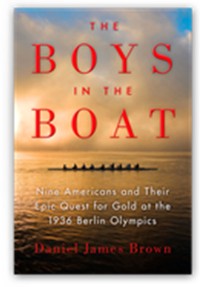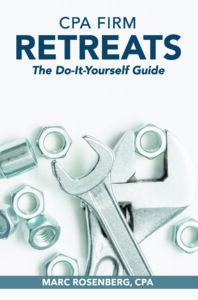#1 Way to Build a Strong Culture in Your Firm
 I was recently asked: What ONE change do you recommend that firms undertake to make their firm culture more engaging and attractive to the next generation leader?
I was recently asked: What ONE change do you recommend that firms undertake to make their firm culture more engaging and attractive to the next generation leader?
My suggestion:
Get everyone on the same page. Align the firm with partners AND staff who have similar values. Related to this, align the firm’s CLIENTS that allow firm personnel to do the kind of work that is most satisfying and enjoyable to them instead of the usual helter-skelter amalgamation of “good” and “bad” clients. Along the way, with these alignments, accountability will come easier.
One of the main reasons that accountability is so difficult is because there are partners that don’t want to be held accountable for something they don’t believe in or that they feel was forced down their throat.
Most partner retreats focus on one or more of these areas: (1) plan the firm’s future, (2) explore changes/resolve high-level problems and challenges and (3) strengthen the firm’s one-firm culture with the communications between partners that take place at a retreat, thereby getting the partners “on the same page.”
CPA Firm Retreats: The Do-It-Yourself Guide was written to help firms organize and facilitate retreats. Chapters include ►ground rules for participants, ►alternative retreat formats, ►logistics ►how to implement retreat ideas. Half the book provides specific discussion questions that the facilitator can use to stimulate conversation in topics such as ►profitability, ►managing staff, ►mergers, ►succession planning, ►marketing, ►partner accountability, ►firm governance, ►partner compensation and ►partner buyout plans.
For an inspiring account of the benefits of teamwork read The Boys In The Boat, by Daniel James Brown. The book is based on the true story of how nine working-class students at The University of Washington came together in the 1930s, with no prior training, to defeat the elite college teams on the East and West coasts and move on to defeat the German team rowing for Adolph Hitler in the Berlin Olympics, shocking the world.
Intuitively, one might think that the best rowing teams had the strongest, biggest, committed athletes. But those who knew the sport well understood that winning at rowing takes so much more brain than brawn. The best teams had (1) the best methods, (2) the best strategies, (3) personalities that meshed and were accountable, (3) crew members that followed their leaders, continually striving to improve and excel, even when they already were world-class.
But most of all, the best crews had precision timing. Their oars had to touch and leave the water with synchronicity. Not just a few times. But throughout the entire race. The crews that had this timing could out-row crews manned by athletes with 20-40% more strength.
Don’t read this book because you like sports. Read the book because you want to see how the highest level commitment to creating an engaging culture make an organization perform at an elite level.
1 Comments

CPA Firm Retreats: The Do-It-Yourself Guide
Many firms hire outside facilitators for their retreats. But the majority. especially those under $15M, facilitate their own. In both cases, this all-new edition serves as a complete resource guide to convening a partner retreat that leads to action.
Learn More
What fun to see you also liked this book! I read it thinking I wouldn’t like it at all for a book club this year. However…it was to me the best book of the season and many more. The races were good, but so were the entire stories of what really happened to college students and families during the Depression and what they did to keep going–to school as well as just living.